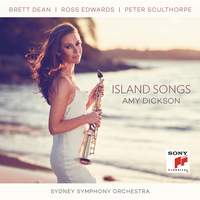Interview,
Amy Dickson on 'Introit' - the music of Gerald Finzi
 Australian saxophonist Amy Dickson has done much to bring the instrument in out of the cold for classical fans - championing both contemporary repertoire and innovative arrangements of works written for other instruments. She's one of the main contributors to the Aurora Orchestra's latest album, Introit, which showcases the music of Gerald Finzi. The Aurora Orchestra are known for their original programming, and this collection of reimagined Finzi delights is no exception.
Australian saxophonist Amy Dickson has done much to bring the instrument in out of the cold for classical fans - championing both contemporary repertoire and innovative arrangements of works written for other instruments. She's one of the main contributors to the Aurora Orchestra's latest album, Introit, which showcases the music of Gerald Finzi. The Aurora Orchestra are known for their original programming, and this collection of reimagined Finzi delights is no exception.
I spoke to Amy about the pieces on this album, and about the unique relationship between arrangements and their "originals".
It seems common for the “Amen” that closes Finzi’s extended choral masterpiece Lo, the full, final sacrifice to be chopped out and recorded as a “piece” on its own – akin to the concert-hall’s “Prelude and Liebestod” or the isolated favourite movements that one hears on the radio, only more so. Do you think this extract stands alone as a “miniature” in its own right?
I think it's very natural, and I think that's what they were looking for when they were looking for pieces to arrange. They were trying to be creative and looking for quite a lot of variety – that particular one wasn't my idea! But it felt very nice to play with the orchestra, and the arrangement's very nice.
Some of these pieces, in particular Fear no more the heat o’ the sun, were written with a baritone voice in mind. To non-players, the level of interchangeability between the various members of the saxophone family isn’t obvious; could you have chosen to play these numbers on a deeper instrument, and if so, why did you go for the higher octave?
It's an interesting and difficult-to-answer question. I first had this predicament when I did my Glass album and transcribed The Protecting Veil for saxophone. And because it's on the cello, I assumed that it would suit better on a lower instrument, so I originally made the arrangement for the alto saxophone. And I started to play it and I thought 'this sounds terrible!' – and then I put it onto soprano and it just felt perfect. It was extraordinary how the higher instrument seemed to work better than the lower one. And it was the same again here. There was just something, I don't know what it is, but there's something about the different timbres of the different saxophones – and they are dramatically different – so it just feels right with some pieces.
And it's also really interesting when I play with orchestras, especially when it's not just strings, and my line is doubled by various wind instruments – the way the different saxophones mix and merge with the different instruments. It's fascinating, and sometimes the soprano really matches with the sound of the oboe or the flute, but then the alto will match different instruments in the orchestra. I think in a way it all depends on the orchestration, as well.
More generally, in a lot of cases these arrangements use the saxophone as a fairly straightforward like-for-like replacement for the vocal line. In the past it’s often been the cello that is most closely compared to the human voice; do you think the saxophone is particularly suited to this in terms of timbre?
Yes – I sometimes feel like I'm singing when I play. I think it's a very 'singing' instrument, or it can be. The saxophone is one of the most versatile instruments there is – it can sound completely different. If you put my sound next to someone like Charlie Parker, it's a completely different instrument. My musical voice is obviously very different to his. So even talking about the saxophone as an instrument is itself a difficult thing to do! But yes, it can do, and I would hope – especially on this album – that it sounds like a singing instrument.
Most of the arrangements are fairly unobtrusive, but some involve quite substantial changes – eg the replacement of the bell-like low piano chords in Come away, death with suspenseful high strings. How far do you think these new “takes” on Finzi depart from his original pieces?
It's hard to measure against anything in particular, but I think if you're going to arrange something originally for piano and voice for saxophone and orchestra, it's going to change a bit! And again, it's just whether or not it ends up being convincing in the new version. You can't really compare them, and it does become a new piece.
Obviously the link to Finzi was through the Finzi Trust – we couldn't actually speak to the composer in this instance, but I do work a lot with new music and when I'm doing arrangements I try to arrange music by living composers, so that I can ask them for their permission and get them to look over it first. And usually, if it's going to be done really convincingly it does have to become a new piece. It's silly to just try to do the same thing on a different instrument – why would you do that? Why not just play music for your own instrument? So I think again it is becoming a new idea.
It says something about the arranger as well. A good portion of this version is their ideas and their creativity, and from my experience of working with composers, nearly all of the time when I ask somebody if I can arrange their music and I show them what I've done with it they're really happy to have it thought of in a different way. And that's music, actually! Once a composer writes a piece of music, they've got to let it go a little bit, because there are going to be different interpretations of it. And most composers I work with like that, they like new phrasing and so on. The dots on the page can only express so much, and there are umpteen different interpretations of the same thing printed on a page. It can't be absolutely definitive relative to what's going to come out of the other end of the instrument. I think most composers are really excited about different ways their music is interpreted. Of course one has to be very true to the score, and that's something I feel very passionate about – especially with contemporary music – but once you've been true to the score, it's obviously a very important part of it to have your own interpretation.
'Introit' was released on 4th March on Decca.
Available Formats: MP3, FLAC, Hi-Res FLAC
Other recordings by Amy Dickson and the Aurora Orchestra
This all-Australian disc takes its title from the concerto by the late Peter Sculthorpe.
Available Formats: MP3, FLAC
Amy plays contemporary concertos and concertante works for saxophone, with the Melbourne Symphony Orchestra under Benjamin Northey.
Available Formats: MP3, FLAC
A program centred around sleep - Britten's haunting Nocturne is the centrepiece of a programme stretching across the centuries from Couperin to R.E.M. arrangements.
Available Formats: MP3, FLAC, Hi-Res FLAC
Nicholas Collon and the Aurora Orchestra take us on an imagined journey across America, featuring traditional folksongs, American classical composers and Paul Simon.
Available Formats: MP3, FLAC







